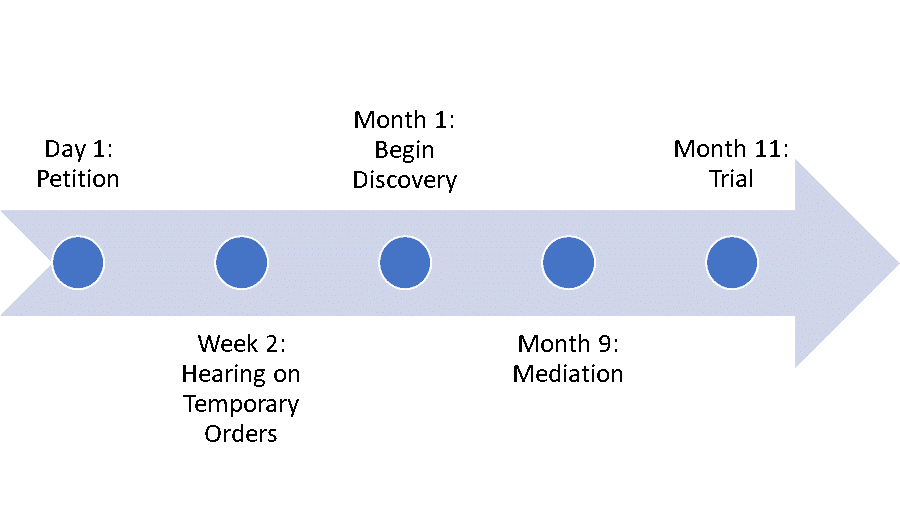by Samuel K. Darling, Bellevue Divorce & Family Law Attorney
This overview briefly describes the process of getting a divorce in Washington State. For those who want more, it links to how-to explanations of every step in the process. In fact, several unaffiliated attorneys say they review these how-to explanations for additional guidance in their own family law practices.
Readers representing themselves might benefit from printing our outline on getting divorced. It is what our new divorce lawyers use to keep track of the process.
Table of Contents
I. How Long a Divorce Takes
II. The Five Stages of the Divorce Process
1) Petition/Response
2) Temporary Orders (Optional)
3) Discovery (Optional), Modifying Temporary Orders (Optional), and Enforcing Temporary Orders (Optional)
4) Mediation (& Presentation of Final Orders, If You Settle)
5) Trial
III. Post-Trial
If concerned about custody, stop reading this article and learn how to position yourself to win custody before anything else. The first spouse to understand and act upon this information often gets the child.
I. How Long a Divorce Takes.
A divorce in Washington takes at least 91 days. Washington has a 90-day cooling-off period preventing people from getting quick divorces during brief fits of anger.
Do not expect YOUR divorce to be over in 91 days. The average appears to be about one year according to statistics in King County and Snohomish County. If one year is average, some cases last longer. Litigation takes patience.
As far as our firm knows, there are only two ways to get divorced quickly. The first is by default. This is when the responding party does not take the necessary steps to participate in the divorce despite being served.
The other way to get divorced quickly is if the parties swiftly reach agreement on all the terms. If you and your spouse just want reach agreement and enter an “uncontested divorce”, instead see our articles on negotiating pre-filing settlements and entering agreed orders.
II. The Five Stages of the Divorce Process.

1st Stage: Petition/Response.
The process begins by one party filing a divorce petition. The petition is the document that says the petitioner wants a divorce. Most petitions are basic documents putting the other side on notice of the case. The petition is filed with the court along with supporting documents and served upon the other spouse, called the respondent.
The respondent usually has 20 days to respond to the petition by submitting a Response to Petition for Divorce. The response to the petition is a simple check-the-box document that only takes a brief sitting to complete. Failing to submit the response on time can lead to a default. Default, in turn, means the respondent cannot participate in the case.

Practice Tip 1.1: If You Have Children (Skip If Just Want an Overview)
Shortly after the time of petition, local rules might require parents to take a class, such as 4 Kids’ Sake. A local rule is one that applies to the county of your case. Speak with a family law facilitator in the county about whether you need to take a class and which one. Facilitators are available in the courthouse and charge $10 per session. Sign up as soon as the case begins but not before. You might not receive credit for taking the class if you do it too soon.
Make a copy of the certificate of attendance, and file it with the court clerk’s office for the county of your divorce. Make sure to file this within roughly two months of the petition. Otherwise the court might hold it against you at hearings or trial.
It is also important to follow the advice in the parenting class. The advice may be crucial to your children’s mental health, and the court sometimes punishes parents for saying certain things around the children.
2nd Stage: Temporary Orders (Optional).
Given that the average divorce takes about a year, parties often need or want temporary orders that stay in place until the process ends. These temporary orders can address countless topics. Typical ones include who gets to live in the home, a temporary parenting plan, temporary child support, appointing a Guardian ad Litem (see Practice Tip 2.1 below), temporary spousal maintenance, requiring a spouse to find work, and temporary attorney fees. Either party can file a motion for temporary orders at any time, but the petitioner commonly does it at the beginning of the case. The first person to file the motion for temporary orders gains a procedural advantage over the party responding to the motion, so many petitioners take the first opportunity.

Normally the hearing on temporary orders takes place about two weeks after the requesting party filed his or her motion. This allows time for the other party to prepare a written response to the motion for temporary orders.
If the requesting party cannot wait two weeks for temporary orders, he or she can instead request emergency ex parte orders, otherwise called immediate restraining orders. As the name suggests, those go into effect immediately, but they are also rare. A full hearing on temporary orders follows approximately two weeks after entry of emergency orders.
Practice Tip 2.1: Regarding GALs (Skip If Just Want an Overview)
Sometimes the hearing on temporary orders results in the court appointing a Guardian ad Litem, or GAL. A GAL investigates the parties’ parenting and makes custody-related recommendations to the court.
Assuming the court appoints a GAL in your case, you should write him or her a letter or email describing your parenting-related concerns. You should also provide the GAL copies of the documents filed with the court up to that point in the case (and any additional documents you file from that point forward).
Always tells the truth when dealing with a GAL. Clean your house and have your child(ren) play an educational activity rather than watch the TV before and during any GAL visits. It can also be a good idea to draft and rehearse talking points about your advantages as a parent.
3rd “Hazy Middle” Stage: Discovery (Optional), Modifying Temporary Orders (Optional), and Enforcing Temporary Orders (Optional).
This middle stage is nebulous. A party could take several actions, but they are optional.
After getting temporary orders, one or both parties usually initiate discovery. Discovery is the process of obtaining information and documents relevant to the divorce. Washington divorce litigants have many discovery devices at their disposal, meaning ways of getting information. The most common is a thick packet of requests called interrogatories and requests for production. The recipient normally has 30 days to comply.
Around this time one the parties might also file a motion to modify the temporary orders if there has been a change in circumstances. A common change in circumstances takes place when the GAL issues his or her report with recommendations on the parenting plan. The court will usually adopt the GAL’s recommendations as a modified temporary parenting plan if a party files a motion for it.
During this stage a party might also elect to file a motion to enforce an order if the other party has failed to take required action(s).

Practice Tip 3.1: Regarding Discovery
Propounding discovery might or might not be a good idea in your situation. If you have all the information you need, propounding discovery might increase the difficulty of your case without any significant benefit. Moreover, if you propound a set of interrogatories and requests for production on the other side, they often do the same to you. Responding to interrogatories and requests for production takes days of nonstop work.
Practice Tip 3.1: Local Rules (Skip If Just Want an Overview)
It might or might not be necessary to request a trial date in your case. Some counties automatically assign trial for a date about a year after the petition. Counties that automatically set trial dates will send a case scheduling order or similar notification at the beginning of the case. King County is the most notable example. King County issues case schedules with numerous deadlines so parties can more easily comply with the county’s myriad local court rules.
Other counties require one of the parties to request a trial date. Do it in this stage if applicable. Courts are busy and typically assign trial dates months after the request. The exact process of requesting a trial date varies from county to county, but local family law facilitators can assist.
4th Stage: Mediation (& Presentation of Final Orders, If You Settle).
Parties usually mediate after discovery and before trial. In fact, most counties’ local court rules require divorcing parties to engage in some sort of alternative dispute resolution before trial, and mediation is the most popular option. It involves an unbiased person helping the parties reach agreement on all the terms of their case. Mediation at this stage results in settlement most of the time.
Assuming you settle, one of the parties would present agreed final orders ex parte, the fastest means of wrapping up the case.

5th Stage: Trial.
If parties cannot reach agreement, they go to trial, where a judge decides the terms of the divorce. Only about 5% of cases make it this far. Most cases settle earlier in the case, often at mediation.
Trial can be extremely expensive, typically costing as much in attorney fees as the rest of the case combined. Preparations begin more than a month in advance, so do not wait until the last moment.
III. Post-Trial.
Our firm has separate articles on what you should know after your divorce.
That’s it! We hope this was helpful. Our firm believes in making quality legal information available for free on the internet. For more, visit our website and click the resources tab in the upper right corner.
Recommended Articles & Videos:
- How Much Does a Divorce Cost in Washington State?
- Unbundled Legal Services: Representing Yourself with Limited Help from an Attorney
- Property Division in WA Divorces: The Basics
- Spousal Maintenance (Alimony) in Washington State
- Calculating Child Support: The Basics
- Types & Examples of Parenting Plans | Washington State
- How to Force People to Give Information
- Will My Spouse Have to Pay My Divorce Attorney’s Fees?
- Settling Before Filing for Divorce
- Secret Recordings in Washington Divorces
- Tips on Keeping Your Divorce Attorney’s Fees Low
- How to Get an Immediate Restraining Order
- Win Custody: How to Position Yourself
- What Can’t I Tell My Kids In a Divorce?
- The Difference between Legal Separation & Divorce | WA
- Can’t Afford a Lawyer for My Divorce | WA
- Can I Get Divorced In Washington State If I Just Moved Here? Probably
- Arbitration
Comment below to tell us and other readers about our article(s), how we can improve them, and additional topics you would like our article(s) to address.


Hi, I would like to inquire if you handle case like i have. Me and my ex husband are foreigner, my husband is from Europe and Im Philippines. We both work on the ship. We got Married in Tampa Florida. We are not citizen or dont have green card. For now, I have my boyfriend, he’s living in the US , and we planning to get married in the future, Is there any way i can get divorce from my Ex husband even im currently leaving in Philippines? We dont have property issues and no kids
Thank you
Aiz
Hi Aiza. Unfortunately Washington’s rules of professional conduct prohibit me from using the comments section of this article to advise you on the facts of your case. Our firm would need to perform a client intake and check for conflicts of interest before offering legal advice of that type. If you’re looking for free information on whether you can file for divorce in Washington, see our firm’s article on How to File for Divorce in Washington, especially the section on Where to File. If you’d instead like our firm advise you on the facts of your case, don’t hesitate to contact us by phone or email.
Hello I retained an attorney after my wife fled the state on August, 20th 2021 to Oregon for divorce an custody/jurisdiction back here in Washington State I finally had my temporary orders hearing this week 5 months later an the judge granted her the children an now i only get 4 hours supervised visits every Saturday an ordered to pay her child support for our 3 children $1200 month she is claiming all kinds of abuse, violence when they are absolutely false accusations I feel I have not been considered fairly in this circumstance I haven’t seen my children in 5 months missed there 1st an second birthday’s I feel the attorney that I have is not concerned about me as he never communicates with me at all he had me write out my statements the week before the hearing, in when I saw her statement it was done back in November I really feel I need to withdraw from him being my attorney an really need assistance in this matter as I cannot travel to Oregon every Saturday just for a 4 hour visitation with my children she is definitely alienating them from me we also just bought a home this last May an has sabotaged me with this purchase as I am barely floating. She recently got an apartment an working at the school my 5 year old is attending.
???2016???????? ?????????? ?????????? ??????? ???????? ??????? ????? ???????????? ??????????????????????????? ????????? ????????????????????
I married my wife in 2021 and shortly after I quit my job to follow her on her job career which requires her to travel from state to state. After 2 years on the road, the loneliness got too hard to bare and I was getting depressed. It caused us to grow apart and now she wants to leave me with nothing. I gave up so much to just be left behind without any ways or means. We have items in storage together, she took care of all my medical info which I don’t have. I want to know what my options are. Please contact me, thank you.
To whom it may concern,
Me and my wife got separated and we’re having trouble to get divorce.
We got married at King county (Seattle).
Since I live in Israel and she lives in Canada at the moment we’re having a hard to file divorce.
Best regards,
Ben
I’m inquiring for a friend. His wife is packing up, selling large belongings (her own) & leaving the state. They’ve had turmoil for several years, mostly after the death of their only child just before she 6th birthday in 2013 (my husband was her godfather), but they have continued to reside in same home. Both names on the home, but he has contributed most if not all of the financial responsibilities even though they both have incomes. He was willing to sell & split or buy her out, but now it has come to light that she has been in a “relationship” with another. He now feels that he does not want her to profit for all that he has paid for, now that she is proven to have committed adultery, drug & alcohol abuse & her threats of physical violence to him, he feels she is not entitled to receive any home funds. Not sure how she will react as she has been very frequently volatile from moment to moment, day to day. Her adult son tried to reason with her out of concern, & she called the police & had him removed from the property which is not like her to act this way toward her son. If she just leaves the state as she is planning, will it help him at all to file abandonment of spouse, home & property in disso paperwork? Please advise. TYIA
I am inquiring about my friend Indian family, green card holder. They are staying in US last 3-4 years , have 1 house and both are paying EMI equally. Due to unforeseen incident in their marriage, they are deciding to get divorce.
Can they do divorce in US or should they move to India for same ? What will be happen to house which is in both the names as owner ?
Kindly help to guide the procedure and what all things and implications will affect them.